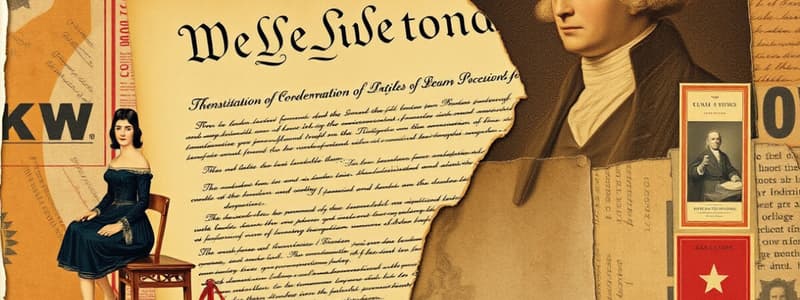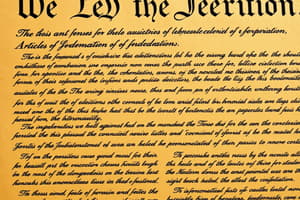Podcast
Questions and Answers
What is the significance of the power of instituting impeachments within the legislative body?
What is the significance of the power of instituting impeachments within the legislative body?
- It provides a safeguard against judicial misconduct. (correct)
- It allows judicial members to create laws.
- It serves as a check on the legislative members themselves.
- It gives the legislative body control over executive appointments.
In the context of the constitutional framework, which of the following best describes the role of the legislative body's impeachment power?
In the context of the constitutional framework, which of the following best describes the role of the legislative body's impeachment power?
- It facilitates the formation of political parties.
- It exclusively empowers the executive branch to appoint judges.
- It grants the legislative body the power to revoke amendments.
- It enables the legislative body to exert influence over judicial independence. (correct)
Which document outlined debates concerning the power of impeachments?
Which document outlined debates concerning the power of impeachments?
- The Bill of Rights
- The Federalist Papers (correct)
- The Emancipation Proclamation
- The Articles of Confederation
Which resource could provide further insight into the debates surrounding the U.S. Constitution's ratification?
Which resource could provide further insight into the debates surrounding the U.S. Constitution's ratification?
Which historical figure is NOT commonly associated with the Federalist Papers?
Which historical figure is NOT commonly associated with the Federalist Papers?
What was the main concern of the Anti-Federalists regarding the Constitution?
What was the main concern of the Anti-Federalists regarding the Constitution?
What was promised by the Federalists to address the concerns of the Anti-Federalists?
What was promised by the Federalists to address the concerns of the Anti-Federalists?
How many states were required to ratify the Constitution for it to take effect?
How many states were required to ratify the Constitution for it to take effect?
What role did the Bill of Rights play in the ratification process?
What role did the Bill of Rights play in the ratification process?
According to the Anti-Federalists, what is the significance of civil liberties?
According to the Anti-Federalists, what is the significance of civil liberties?
What was the outcome for the Constitution by June of 1788?
What was the outcome for the Constitution by June of 1788?
What did John DeWitt II argue about the necessity of a Bill of Rights?
What did John DeWitt II argue about the necessity of a Bill of Rights?
What was the effect of the amendments known as the Bill of Rights?
What was the effect of the amendments known as the Bill of Rights?
What was a significant flaw of the Articles of Confederation?
What was a significant flaw of the Articles of Confederation?
What was the main outcome of the Constitutional Convention?
What was the main outcome of the Constitutional Convention?
Who primarily authored the Virginia Plan?
Who primarily authored the Virginia Plan?
What was the approach of the Virginia Plan towards representation in the legislature?
What was the approach of the Virginia Plan towards representation in the legislature?
What did the New Jersey Plan propose?
What did the New Jersey Plan propose?
Which of the following was a demand from the delegates during the convention?
Which of the following was a demand from the delegates during the convention?
The inability to veto amendments under the Articles of Confederation meant that:
The inability to veto amendments under the Articles of Confederation meant that:
What key issue did the Constitutional Convention address in relation to different states?
What key issue did the Constitutional Convention address in relation to different states?
Flashcards are hidden until you start studying
Study Notes
Adoption of the United States Constitution
- The current U.S. Constitution replaced the ineffective "Articles of Confederation," which provided weak federal government authority.
- Under the Articles, the federal government could not impose taxes, regulate commerce, or amend its own articles due to state veto power.
- In February 1787, the Confederation Congress called a convention aimed at proposing amendments to the Articles of Confederation.
The Constitutional Convention
- Delegates quickly decided to create a completely new document to address national needs.
- The "Virginia Plan," put forth by James Madison and Edmund Randolph, proposed increased federal powers and a bicameral legislature based on state population.
- The lower house representatives would be directly elected by the people, while the upper house would be elected by the lower house from state legislature candidates.
- The Virginia Plan favored larger states, igniting a debate with the "New Jersey Plan" introduced by William Paterson, which supported smaller states.
- By early 1788, five states ratified the Constitution, but concerns over civil liberties led to further debate.
Bill of Rights and Ratification
- To address Anti-Federalist concerns about civil protections, Federalists promised to introduce a Bill of Rights after ratification.
- This compromise enabled the remaining states to ratify the Constitution by June 1788.
- The new government began operating in March 1789 with elections for Congress and the Presidency.
Anti-Federalist Concerns
- Anti-Federalists argued against the absence of a Bill of Rights, highlighted in John DeWitt II's essay, asserting natural rights must be secured through a written compact.
- They emphasized the inherent risks of granting power to the government without substantive checks on its authority.
- The Anti-Federalist position stressed the importance of protecting civil liberties against potential governmental overreach.
Studying That Suits You
Use AI to generate personalized quizzes and flashcards to suit your learning preferences.



